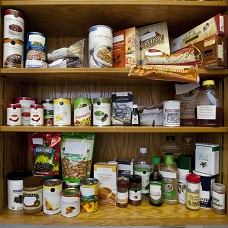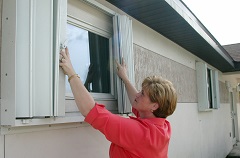Prepare Before Hurricane Season Begins

By Yvonne Florian
Hurricane season will be upon us June first. While a disaster can strike at any time of the year, now is the time to do your Hurricane preparations such as:
- Trim landscape trees
- Clean up any accumulated outdoor objects
- Haul away yard debris, broken outdoor furniture, unwanted items
- Access your hurricane shutters- are they labeled?
- Trim hedges for ease of access to install your shutters
- Check windows, doors, and siding for watertight caulking
- Fill propane tanks
- Stock your pantry
- Drinking water
- Emergency supplies
- Make a family evacuation plan– will you stay or evacuate?
- Make a household inventory – list your valuables

The Pantry
In 2024, one thing we’ve all learned about stocking a hurricane pantry is that it comes in handy for more than just storm season. Another is that we should only buy things we will eat. For example, don’t buy sardines if no one in your house will eat them. Think about the canned, dried, boxed, and non-perishable food items you would usually buy on your weekly grocery list. Buy two or three extra of these each time you shop. Remember to rotate your pantry items to use the older foods stuffs first. You may also want to add just a few comfort foods and nutrition bars for quick meal replacements for those long days of clean-up after the storm. You will most likely be using more calories than you normally would.
Pantry Tip: Use a permanent marker to clearly mark the expiration date on all your canned goods. This makes pantry rotation much easier.
Emergency Supply Kit
Some other emergency supplies would depend upon your family size, small children, the elderly and any pets or livestock you have. And most of the items you will need for clean-up after the storm should be kept within easy reach.
- flashlights & battery-powered lanterns
- battery-powered fans
- a battery powered radio
- First Aid Kit, including instructions for snake bite
- A set of battery-powered LED string lights will light up a whole room
- insect repellent & sun screen
- hand sanitizer
- outdoor work gloves.
- hand tools, trimming saw, pruners
- rechargeable driver-drill may be needed to install and remove storm shutters
Water
You will need bottled water during and after a storm. The ‘rule of thumb’ for water is: One gallon of drinking water per person per day plus more for cooking and washing. It is a good practice to always keep a three-day supply of drinking water at all times in Florida.
As we approach hurricane season, I try to store double the amount of water we would normally use in a week. This can be kept in sanitized refillable jugs. If you are not keen on storing your own tap water, there are coin operated “water machines” in most grocery stores. These are usually equipped with a reverse osmosis (RO) and ultra violet (UV) light treatment systems. You bring your clean jugs and the water-vending-machine dispenses purified water by the gallon or 5-gallons. Do your research on using RO water for everyday drinking. If you have a municipal water supply, you may fill your water jugs from your tap and it will keep for months. The University of Florida’s Institute of Food and Agricultural Sciences Electronic Data Information Source (UF/IFAS EDIS) has many information-packed publications on storing drinking water and water safety.
After a storm or flood, be sure to follow your city’s water safety protocols. If there has been an extensive power outage or flooding, you may be required to boil your water for safety. For those with a household well, you may need to “sanitize your well” before you can safely drink your water after a disaster.

Other Pre-disaster preparations
There are probably as many different things to consider when preparing as there are people. Each situation will be different. If you have a boat, small children, aging parents, tenants, or livestock to consider, your preparations may differ greatly from your neighbor’s. Now is the time to make those plans. The following is another list of things to consider when making your disaster plans:
- check/tune-up the generator
- create your safe room plans
- think about pets and livestock
- clean out the refrigerator & freezer, use up anything you won’t use in a week.
- have a plan for your boat
- list important phone numbers: doctor, pharmacy, E.O.C., Insurance company & policy numbers, contractors you may need after storm is over, far away family
- refill all prescription medications
- fuel up your vehicles
- fuel for generator
- Create a household inventory list with photos, model numbers, year purchased

Last minute storm preparations
Once you have your plan, your inventory, your pantry, and your water all squared away, there will be those last minute preparations. 24 hours before imminent hurricane arrival there are a few things left to do.
- charge all cell phones
- charge all drill & driver tools
- charge your laptop
- charge the portable DVD player
- pack a small “go” bag for a short evacuation
- put batteries in all flashlights, radio, and a fan
- unplug appliances small & large once the power begins to flicker
- ice your coolers
- put up storm shutters or plywood
- Evacuating? Shut off house power & water as you leave
- place charged cordless drill with driver bits in vehicle floorboard, along with a good hand saw.
Recovery
After the storm it will be important to contact insurance agents BEFORE you do any major clean-up. Your insurance adjuster will need to see what happened to determine how to help.

Be sure to keep yourself fed and well hydrated. After-storm-clean-up is a grueling task and it will be hot, humid, and seem never-ending. Take frequent breaks, talk to neighbors, lend a hand if you can. Also, there will be more displaced wildlife after a storm is over. Keep vigilant for them where you may not have ever seen wildlife before. Some of the common wildlife sightings after a storm for me were hummingbirds, strange butterflies, a poisonous snake, ducks, and alligators. Lost pets have found their way to our area including dogs, cats, chickens, parakeets and a cockatoo.
Your local county government should have an Emergency Operations Center or Department of Emergency Management. Find out now if they have a phone number and website for updates. You may contact them or listen to their designated local radio station for updates and disaster plans. They may even have volunteer opportunities during or after disasters if you can help.
For more Disaster Preparedness information, the following publication links will be handy:

University of Florida’s Institute of Food and Agricultural Sciences EDIS publications:
UF’s “Disaster Preparation and Recovery Website”
“Hurricane Preparation: Evacuating your Home”
“Best Management Practices for Equines in Natural Disasters”
The EDIS “Hurricane Preparation” topic page
The “Disaster Planning Tips for Caregivers of the Elderly and People with Disabilities”
“Emergency Considerations for Beef Cattle” is a great resource for Dairy and Ranch.
“How to Prep Your Chickens for a Hurricane” from Grubbly Farms blog
Another great place for lists and plans is the Department of Homeland Security’s Disaster Preparedness website.
Red Cross, “Hurricane Preparedness” website is very thorough and includes instructions for creating a First Aid Kit.
 2
2

Comments:
August 4, 2023
I can email you the recipes today.
August 4, 2023
How can I get the recipes?
May 13, 2021
I like the lists, very thorough. And those links to references within IFAS, the CDC, and the Department of Homeland Security are great resources. It is also a good idea to have your roof inspected sometime well before a storm. This may recertify your roof and make your insurance company happy, maybe even happy enough to give a discount.
Comments are closed.